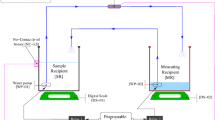Summary
Objective digital determination of CSF spaces is discussed, with ventricular and subarachnoid spaces handled separately. This method avoids the difficulty of visual definition of ventricular borders in planimetric measurements. The principle is to count automatically all pixels corresponding to CSF in a given region with a Hounsfield unit and to multiply this number by the pixel size. This will give the total surface area of CSF spaces in square millimeters. The calculation of pixel values for CSF spaces and brain tissue is experimentally formulated taking the intersection of the Gaussian curves for ventricular content and brain tissue. In practice, the determination of CSF spaces is done by first calculating a histogram of the total brain in a given slice defining all CSF spaces. Next a histogram of a region including ventricles with adjoining tissue is calculated and the ventricular size is calculated. By subtraction of the ventricle value from the total CSF space value, the subarachnoid space size is obtained. The advantages of this method will be discussed.
Similar content being viewed by others
References
Barron, S. A., Jacobs, L., Kinkel, W. R.: Changes in size of normal lateral ventricles during aging determined by computerized tomography. Neurology 26, 1011 (1976)
Becker, H., Grau, H., Schneider, E., Fischer, P. -A., Hacker, H.: CT examination series of Parkinson patients. In: Cranial computerized tomography, p. 249 (eds. W. Lanksch, E. Kazner). Berlin-Heidelberg-New York: Springer 1976
Evans, W. A.: An encephalographic ratio for estimating ventricular enlargement and cerebral atrophy. Arch. Neurol. Psychiatry 47, 931 (1942)
Fischer, P. -A., Jacobi, P., Schneider, E., Becker, H.: Correlation between clinical and CT findings in Parkinson's syndrome. In: Cranial computerized tomography, p. 244 (eds. W. Lanksch, E. Kazner). Berlin-Heidelberg-New York: Springer 1976
Gyldensted, C.: Measurements of the normal ventricular system and hemispheric sulci of 100 adults with computed tomography. Neuroradiology 14, 183 (1977)
Haug, G.: Age and sex dependence of the size of normal ventricles on computed tomography. Neuroradiology 14, 201 (1977)
Huckman, M. S., Fox, J., Topel, J.: The validity of criteria for the evaluation of cerebral atrophy by computed tomography. Radiology 116, 85 (1975)
Meese, W., Lanksch, W., Wende, S.: Cerebral atrophy and computerized tomography-aspects of a qualitative and quantitative analysis. In: Cranial computerized tomography, p. 222 (eds. W. Lanksch, E. Kazner). Berlin-Heidelberg-New York: Springer 1976
Schiersmann, O.: Einführung in die Encephalographie, Stuttgart: Thieme 1952
Walser, R. L., Ackerman, L. V.: Determination of volume from computerized tomograms: Finding the volume of fluid-filled brain cavities. J. Comp. Axial. Tomogr. 1, 117 (1977)
Author information
Authors and Affiliations
Additional information
This project has been supported by the Deutsche Forschungsgemeinschaft
Rights and permissions
About this article
Cite this article
Hacker, H., Artmann, H. The calculation of CSF spaces in CT. Neuroradiology 16, 190–192 (1978). https://doi.org/10.1007/BF00395247
Issue Date:
DOI: https://doi.org/10.1007/BF00395247




